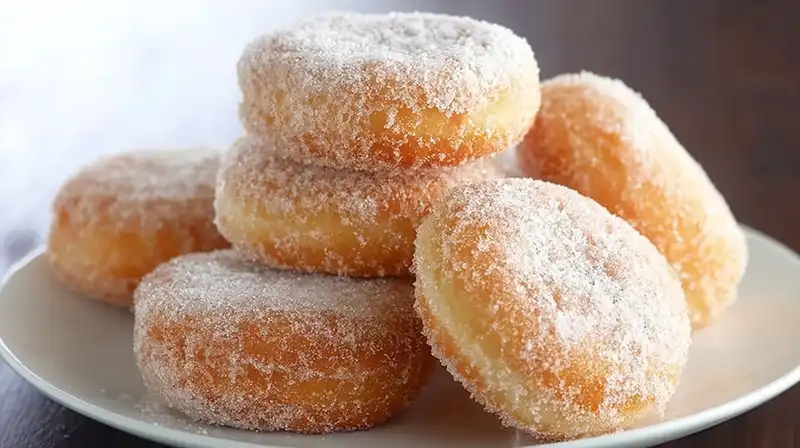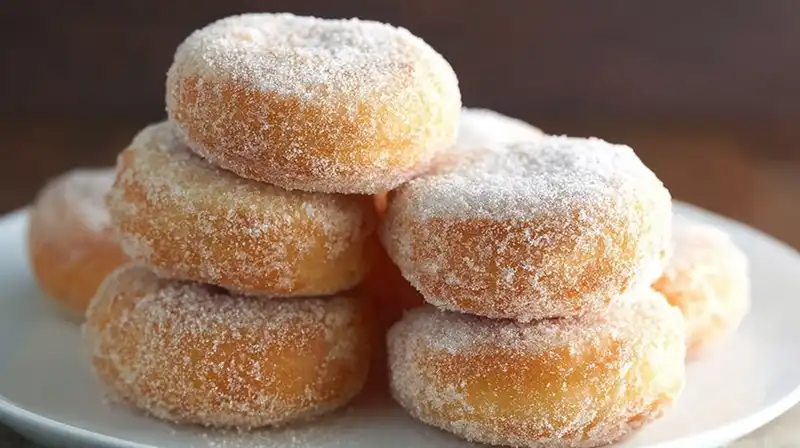Introduction of Chinese Donuts
Imagine biting into a warm, golden pillow of dough, the crisp exterior giving way to an irresistibly soft and airy center, each bite coated in a delicate layer of sugar that melts on your tongue. That’s the magic of Chinese Donuts – a treat so simple yet so indulgent, they’ve earned a place at buffets, bakeries, and family kitchens across the globe.
Table of Contents
As a professional chef, I’ve seen countless versions of this beloved fried dough, but few match the satisfaction of making them at home. Here, you control the texture, the sweetness, and even the cooking method – whether you’re going for the authentic restaurant-style fry, a quick five-minute shortcut, or a lighter baked or air-fried twist. Each approach delivers its own charm, and I’ll guide you through all of them with chef-tested tips so you get flawless results every time.
What makes these donuts truly special is their versatility. Enjoy them fresh for breakfast with coffee, serve them as a sweet lunch side, pair them with dessert sauces after dinner, or bring them to the table as an unexpected party treat. No matter the occasion, these golden bites are guaranteed to disappear fast.
If you’ve been craving that nostalgic buffet-style flavor or simply want to impress with something easy yet impressive, you’re in the right kitchen. Let’s roll up our sleeves and create the best Chinese Donuts you’ve ever tasted – right from your own home.

Chinese Donuts 8 Genius Ideas for Unforgettable Bites
Equipment
- Heavy-Bottomed Pot or Dutch Oven
- Deep-Fry Thermometer
- Food Processor or Mixing Bowl
- Pastry Cutter or Fork
- Rolling Pin
- 2 inch Biscuit Cutter
- Slotted Spoon
- Paper Towels or Paper Bag
- Wire Rack
Ingredients
For the Dough
- 2 cups all-purpose flour 255 g
- 2 tsp granulated sugar
- 1/2 tsp fine sea salt
- 2 1/2 tsp baking powder
- 6 tbsp cold unsalted butter 85 g, cubed
Wet Ingredient
- 3/4 cup whole milk 170 g, room temperature
For Frying
- canola oil enough to fill pot 2 inches deep
For the Coating
- granulated sugar for coating warm donuts
Instructions
- Heat the oil: Pour about 2 inches of canola oil into a heavy-bottomed pot. Attach a deep-fry thermometer and warm the oil over medium heat to 350°F (175°C). Stable temperature prevents greasy or undercooked donuts.
- Combine dry ingredients: In a food processor or large bowl, mix the flour, sugar, salt, and baking powder until evenly blended.
- Cut in butter: Add the cold cubed butter. Pulse or use a pastry cutter until the mixture resembles coarse crumbs with pea-size bits. Cold butter creates a tender, fluffy interior.
- Add milk: Pour in the milk and stir just until a soft dough forms. Do not overmix.
- Shape: Lightly flour your surface. Turn out the dough and dust the top with flour. Pat or roll to 1/2 inch thickness. Cut rounds with a 2 inch biscuit cutter, gathering scraps and repeating as needed.
- Fry: Carefully slide several dough rounds into the 350°F oil without crowding. Fry about 2 minutes per side until deep golden and cooked through, adjusting heat to maintain temperature.
- Drain and coat: Transfer donuts to paper towels or a paper bag to remove excess oil. While still warm, roll generously in granulated sugar so the coating adheres.
- Serve: Enjoy warm for the best texture, or at room temperature. Donuts are best the day they are made.
Notes
More Favorites from My Kitchen:
Chocolate Caramel Fig Tart 7 Irresistible Secrets You Must Try
Lemon-Lime Cherry Pistachio Cheesecake 7 Powerful Tips for Unforgettable Flavor
Or go to my Pinterest.
Why You’ll Love This Recipe “Chinese Donuts”
- Quick and Easy to Make – From mixing to frying, these donuts come together in under 30 minutes, making them perfect for a last-minute breakfast or sweet snack.
- Simple Ingredients – You only need a handful of pantry staples, so there’s no need for special trips to the store.
- Versatile Treat – Enjoy them warm at breakfast, as a lunchtime pick-me-up, or as a fun dessert after dinner.
- Restaurant-Style at Home – Recreate that buffet-style Chinese Donut flavor without leaving your kitchen.
- Irresistibly Delicious – Soft, fluffy inside with a crispy sugar-coated outside, they’re guaranteed to disappear fast.
What sets this recipe apart is the attention to texture and flavor balance. Instead of overly greasy or dense donuts, you’ll get light, airy pastries with just the right level of sweetness. The technique ensures even frying, while the sugar coating clings perfectly to each piece for that authentic taste and look.
There’s also room for creativity. You can add a hint of cinnamon to the sugar for a warm, spiced twist, dip them in melted chocolate for extra indulgence, or even serve with a side of fruit compote for a brunch-worthy presentation.
Whether you’re looking to surprise guests with a unique homemade treat or simply enjoy a nostalgic favorite, these Chinese Donuts bring comfort, joy, and a touch of culinary magic to your table.
Ingredients Needed for Chinese Donuts
For the Dough
- All-purpose flour – 2 cups (255 g): Standard baking flour that gives the donuts structure while keeping them light and fluffy.
- Granulated sugar – 2 teaspoons: Adds a subtle sweetness to the dough without overpowering the final coating.
- Fine sea salt – ½ teaspoon: Balances the flavors and enhances the overall taste.
- Baking powder – 2½ teaspoons: Ensures the donuts puff up beautifully with a tender crumb.
- Cold unsalted butter – 6 tablespoons (85 g), cubed: Cold butter is key for flaky, tender texture; keep it chilled until mixing.
For the Wet Ingredients
- Whole milk – ¾ cup (170 g): Provides richness and moisture; room temperature is best for smooth mixing.
For Frying
- Canola oil – enough to fill your pot about 2 inches deep: Neutral flavor and high smoke point make it ideal for frying.
For the Coating
- Granulated sugar – as needed for coating: Creates the signature sweet crunch; coat while donuts are still warm for best adhesion.
How to Make Chinese Donuts
- Prepare the Oil for Frying
Pour about 2 inches of canola oil into a heavy-bottomed pot or deep skillet. Attach a deep-fry thermometer and heat the oil to 350°F (175°C) over medium heat. Preheating ensures the donuts cook evenly without becoming greasy. - Mix the Dry Ingredients
In a food processor or large mixing bowl, combine flour, sugar, salt, and baking powder. Pulse or whisk until evenly blended. This step evenly distributes the leavening agent for consistent rising. - Cut in the Butter
Add the cold cubed butter into the dry mixture. Pulse in short bursts or use a pastry cutter to blend until the mixture looks like coarse crumbs. Keeping the butter cold is essential for creating a light, fluffy interior. - Incorporate the Milk
Pour in the whole milk and gently mix until a soft dough forms. Avoid overmixing, as this can make the donuts dense. - Shape the Dough
Lightly flour your work surface. Turn the dough out and dust the top with a little flour. Pat or roll it to about ½ inch thick. Use a 2-inch biscuit cutter or round cookie cutter to cut out circles. Gather scraps and repeat until all dough is used. - Fry the Donuts
Carefully place a few dough rounds into the hot oil, avoiding overcrowding. Fry for about 2 minutes per side, or until golden brown and cooked through. Adjust heat as needed to maintain temperature. - Drain and Coat with Sugar
Remove donuts using a slotted spoon and drain on paper towels or a paper bag to absorb excess oil. While still warm, roll each donut generously in granulated sugar for that signature sweet coating. - Serve Fresh
Chinese donuts are best enjoyed immediately while warm and soft, but they can also be served at room temperature.

Serving and Storage Tips of Chinese Donuts
Serving Suggestions
- Fresh and Warm – Chinese donuts are at their absolute best when served fresh from the fryer while still warm and slightly crisp on the outside.
- Dipping Sauces – Pair them with sweetened condensed milk, chocolate sauce, or a drizzle of honey for a delightful flavor twist.
- Breakfast or Dessert – Serve alongside coffee, tea, or a glass of milk for a comforting breakfast, or plate them with fresh fruit for a beautiful dessert presentation.
- Buffet-Style – If serving for a brunch or party, keep them on a warming tray set to low heat to maintain softness without overcooking.
Storage Guidelines
- Room Temperature – Store cooled donuts in an airtight container for up to 1 day. Keep in a single layer to prevent the sugar coating from dissolving.
- Refrigeration – While refrigeration can make donuts firmer, they can be stored for up to 3 days in a sealed container. Warm slightly before serving to restore softness.
- Freezing – Freeze fully cooled donuts in a freezer-safe bag for up to 2 months. Reheat directly from frozen in a 350°F (175°C) oven for about 8–10 minutes.
Reheating Tips
- Oven – Best for keeping the outside lightly crisp. Warm in a preheated oven at 325°F (160°C) for 5–6 minutes.
- Microwave – For a quick option, heat one donut at a time for 10–12 seconds, but note this may soften the exterior.
Helpful Notes of Chinese Donuts
Oil Temperature is Key – Keep your frying oil at a steady 350°F (175°C). If the temperature drops too low, the donuts will absorb excess oil and become greasy. If it’s too high, they will brown too quickly on the outside while remaining raw inside.
Measuring Flour Accurately – Spoon flour into your measuring cup and level it off with a knife for consistent results. Too much flour will make the donuts dense rather than fluffy.
Butter Matters – Use cold unsalted butter for a lighter, tender texture. Cutting it into the flour creates small pockets of fat that help produce a soft interior.
Sugar Coating Tip – Coat the donuts in sugar while they are still warm so the sugar sticks evenly.
Flavor Variations – Add a pinch of cinnamon or nutmeg to the coating sugar for a warm spice twist, or sprinkle powdered sugar instead for a softer sweetness.
Shape Options – While round donuts are traditional, you can also cut them into strips or twists for variety, especially if serving at parties or brunch buffets.
Serving Suggestion – These donuts pair beautifully with hot tea, coffee, or even a cup of sweet soy milk for a traditional touch.
Conclusion of Chinese Donuts
Chinese donuts are the perfect combination of simplicity, flavor, and comfort. With their golden, crispy exterior and soft, pillowy interior, they offer a delightful bite that works just as well for a quick breakfast as it does for an afternoon snack or sweet dessert. The recipe’s straightforward steps make it approachable for home cooks of all skill levels, while the use of everyday ingredients ensures you can whip up a batch without an extra trip to the store.
One of the most rewarding aspects of this recipe is how versatile it is. You can keep them traditional with a generous sugar coating or get creative with cinnamon sugar, powdered sugar, or even a drizzle of chocolate for a richer twist. Pair them with coffee, tea, or soy milk for an authentic experience, or serve them alongside a fresh fruit platter for a balanced spread.
These donuts are best enjoyed fresh and warm, making them a wonderful treat to share with family and friends. The satisfaction of biting into a homemade donut you’ve crafted from scratch is unmatched, and once you try this method, you’ll see just how easy it is to achieve bakery-quality results in your own kitchen.
If you try this recipe, I’d love to hear about your experience! Leave a comment and a star rating below to let me know how your donuts turned out. Don’t forget to share your creations on Pinterest or Facebook so others can be inspired to try them too. Have you experimented with a unique coating or shape? Share your twist in the comments — your idea might be the next crowd favorite!
Frequently Asked Questions
What are Chinese donuts called?
Chinese donuts are often referred to as “Youtiao” when in long, savory form, or “sugar donuts” in their sweet version found at Chinese buffets. They are deep-fried dough pieces, lightly sweetened and typically coated in sugar when served as a dessert or breakfast treat.
How do you eat Chinese donuts?
They can be enjoyed warm, coated in sugar, and eaten plain as a snack. For a more traditional touch, they’re often dipped into hot soy milk or served alongside congee for breakfast. Sweet versions pair beautifully with coffee or tea.
What are Arabic donuts called?
In Arabic cuisine, donuts are similar to a treat called “Luqaimat” or “Awameh.” These are small, golden dough balls soaked in sugar syrup or honey, offering a crispy outside and soft inside.
What is Patonggo?
Patonggo is the Thai version of Chinese fried dough sticks. They are light, airy, and often served with condensed milk or pandan custard. While not identical to Chinese donuts, they share a similar frying method.
What are 13 donuts called?
A set of 13 donuts is often called a “baker’s dozen.” This tradition dates back to when bakers added an extra item to avoid penalties for selling short weight.
Is yum yum a donut?
A “Yum Yum” is a twisted, glazed pastry made from laminated dough, giving it a flaky texture. While not a traditional donut, it’s part of the pastry family and is also fried before being coated in sugar glaze.
